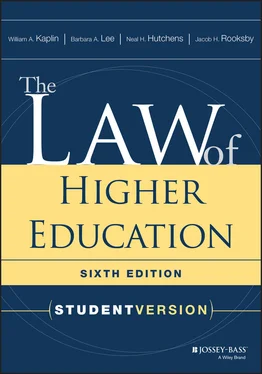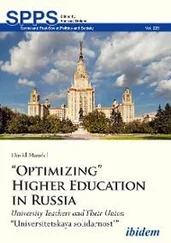Risk assessments (see Section 2.4.1above) are critical to the implementation of risk avoidance and control strategies. Risk assessment teams would therefore be an important organizational device to use with these methods of risk management. Another important organizational device is a crisis management team to manage institution-wide crises, along with other smaller teams to deal with particular crises affecting an individual or a small number of individuals (for example, a mental health crisis).
Purchasing commercial liability insurance is the first way in which institutions can transfer the risk of liability to others. An institution can insure against liability for its own acts, as well as liability transferred to it by a “hold-harmless” agreement with its personnel. With the advice of insurance experts, the institution can determine the kinds and amounts of liability protection it needs and provide for the necessary premium expenditures in its budgeting process.
There are two basic types of insurance policies important to higher education institutions. The first and primary type is general liability insurance; it provides broad coverage of bodily injury and property damage claims, such as would arise in the case of a negligently caused injury to a student or staff member. The second type is directors and officers insurance (“D & O” coverage, or sometimes “errors and omissions” coverage). It typically covers claims for wrongful acts without bodily injury, such as employment claims, student discipline, and due process violations.
General liability insurance policies usually exclude from their coverage both intentionally or maliciously caused damage and damage caused by acts that violate penal laws. Liability arising from the violation of an individual's constitutional or civil rights is also commonly excluded from general liability insurance coverage—an exclusion that can pose considerable problems for administrators and institutions, whose exposure to such liability has escalated greatly since the 1960s. In specific cases, questions about this exclusion may become entwined with questions concerning intent or malice.
Exclusions from coverage, as in the previous examples, may exist either because state law requires the exclusion or because the insurer has made its own business decision to exclude certain actions from its standard coverages. When the exclusion is of the latter type, institutions may nevertheless be able to cover such risks by combining a standard policy with one or more specialty endorsements or companion policies, such as a directors and officers policy. If this arrangement still does not provide all the coverage the institution desires, and if the institution can afford the substantial expense, it may request a “manuscript” policy tailored to its specific needs.
A second method of risk transfer is a “hold-harmless” or indemnificationagreement, by which institutions can transfer their liability risks to other parties or transfer to themselves the liability risks of their officers or employees or other parties. In a broad sense, the term “indemnification” refers to any compensation for loss or damage. Insurance is thus one method of indemnifying someone. But in the narrower sense used here, indemnification refers to an arrangement whereby one party (for example, the institution) agrees to hold another party (for example, an individual officer or employee) harmless from financial liability for certain acts or omissions of that party that cause damage to another.
Like insurance policies, indemnification agreements often do not cover liability resulting from intentional or malicious action or from action violating the state's penal laws. Just as public policy may limit the types of acts or omissions that may be insured against, it may also limit those for which indemnification may be received.
Both public and private institutions may enter indemnification agreements. A public institution, however, may need specific authorizing legislation (see, for example, Mich. Comp. Laws § 691.1408), while private institutions usually can rely on the general laws of their states for sufficient authority. Some states also provide for indemnification of state employees for injuries caused by their acts or omissions on behalf of the state (see, for example, Cal. Gov't Code §§ 995 et seq.) or for torts committed within the scope of their employment (see, for example, Ill. Code, 5 Ill. Comp. Stat. 350(2)(d)).
State laws on defense and indemnification are often general, and may vary considerably from state to state. To have a sound and clear institutional policy, adapted to the academic environment, public institutions may need to expand upon applicable state law.
A third method of risk transfer is the release or waiver agreement. This type of arrangement releases one party from liability to another for injuries arising from some particular undertaking in which both parties are involved. In postsecondary education, this mechanism is most likely to be used for student activities and services, such as intercollegiate athletics, provision of medical services, study abroad programs, and student field trips, which involve acknowledged risks. In such circumstances, the institution may require the student to execute a release or waiver as a precondition to participation in the activity or receipt of the service.
Postsecondary institutions may also use “consent forms” for certain activities or services—for example, a form securing a consent to a particular medical treatment, or consent for the institution to authorize medical treatment on the participant's or recipient's behalf. Consent forms are not the same as releases and will not have the legal effect of a release unless clear exculpatory language, like that used in releases, is added to the consent form. Absent such exculpatory clauses, use of a consent form may actually increase, rather than decrease, an institution's potential liability. In Fay v. Thiel College , 2001 WL 1910037 (Pa. 2001), for example, a college had had students sign medical consent forms before participating in a study abroad trip. The form authorized the college's representatives to secure medical treatment in case of emergency. The plaintiff, a student who became ill on the trip and was left behind for medical treatment at a medical clinic, alleged that she had received unnecessary surgery and been sexually assaulted at the clinic. The court held that the consent form created a “special relationship” between the college and the student and that, due to this relationship, the college owed the student a “special duty of care” regarding medical treatment while she was on the trip. The court therefore denied the college's motion for summary judgment and ordered a jury trial on whether the college had breached this duty.
The most practical option for the institution in some circumstances may be to retain the risk of financial liability. Risk retention may be appropriate, for instance, in situations where commercial insurance is unavailable or too costly, the expected losses are so small that they can be considered normal operating expenses, or the probability of loss is so remote that it does not justify any insurance expense. Both insurance policy deductibles and methods of self-insurance are examples of risk retention. The deductible amounts in an insurance policy allocate the first dollar coverage of liability, up to the amount of the deductible, to the institution. The institution becomes a self-insurer by maintaining a separate bank account to pay appropriate claims. The institution's risk managers must determine the amount to be available in the account and the frequency and amount of regular payments to the account. This approach is distinguished from simple noninsurance by the planning and actuarial calculations that it involves.
Читать дальше












